水滑石类材料应用于氧化反应研究最新进展
- 格式:pdf
- 大小:484.66 KB
- 文档页数:14
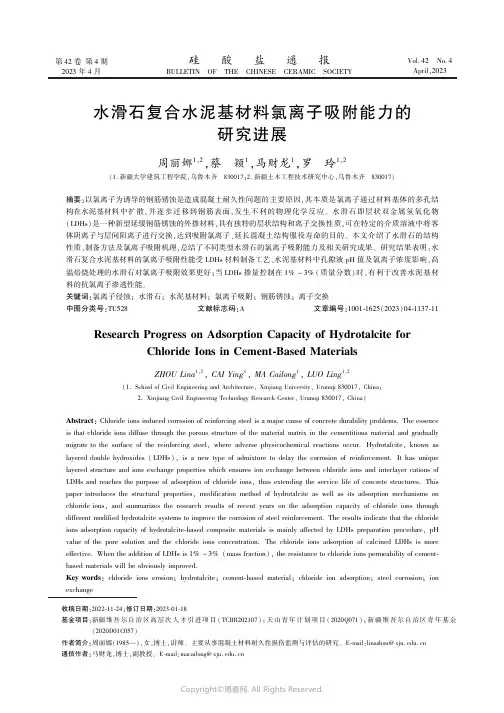
第42卷第4期2023年4月硅㊀酸㊀盐㊀通㊀报BULLETIN OF THE CHINESE CERAMIC SOCIETYVol.42㊀No.4April,2023水滑石复合水泥基材料氯离子吸附能力的研究进展周丽娜1,2,蔡㊀颖1,马财龙1,罗㊀玲1,2(1.新疆大学建筑工程学院,乌鲁木齐㊀830017;2.新疆土木工程技术研究中心,乌鲁木齐㊀830017)摘要:以氯离子为诱导的钢筋锈蚀是造成混凝土耐久性问题的主要原因,其本质是氯离子通过材料基体的多孔结构在水泥基材料中扩散,并逐步迁移到钢筋表面,发生不利的物理化学反应㊂水滑石即层状双金属氢氧化物(LDHs)是一种新型延缓钢筋锈蚀的外掺材料,具有独特的层状结构和离子交换性质,可在特定的介质溶液中将客体阴离子与层间阳离子进行交换,达到吸附氯离子㊁延长混凝土结构服役寿命的目的㊂本文介绍了水滑石的结构性质㊁制备方法及氯离子吸附机理,总结了不同类型水滑石的氯离子吸附能力及相关研究成果㊂研究结果表明:水滑石复合水泥基材料的氯离子吸附性能受LDHs材料制备工艺㊁水泥基材料中孔隙液pH值及氯离子浓度影响,高温焙烧处理的水滑石对氯离子吸附效果更好;当LDHs掺量控制在1%~3%(质量分数)时,有利于改善水泥基材料的抗氯离子渗透性能㊂关键词:氯离子侵蚀;水滑石;水泥基材料;氯离子吸附;钢筋锈蚀;离子交换中图分类号:TU528㊀㊀文献标志码:A㊀㊀文章编号:1001-1625(2023)04-1137-11 Research Progress on Adsorption Capacity of Hydrotalcite forChloride Ions in Cement-Based MaterialsZHOU Lina1,2,CAI Ying1,MA Cailong1,LUO Ling1,2(1.School of Civil Engineering and Architecture,Xinjiang University,Urumqi830017,China;2.Xinjiang Civil Engineering Technology Research Center,Urumqi830017,China)Abstract:Chloride ions induced corrosion of reinforcing steel is a major cause of concrete durability problems.The essenceis that chloride ions diffuse through the porous structure of the material matrix in the cementitious material and gradually migrate to the surface of the reinforcing steel,where adverse physicochemical reactions occur.Hydrotalcite,known as layered double hydroxides(LDHs),is a new type of admixture to delay the corrosion of reinforcement.It has unique layered structure and ions exchange properties which ensures ion exchange between chloride ions and interlayer cations of LDHs and reaches the purpose of adsorption of chloride ions,thus extending the service life of concrete structures.This paper introduces the structural properties,modification method of hydrotalcite as well as its adsorption mechanisms on chloride ions,and summarizes the research results of recent years on the adsorption capacity of chloride ions through different modified hydrotalcite systems to improve the corrosion of steel reinforcement.The results indicate that the chloride ions adsorption capacity of hydrotalcite-based composite materials is mainly affected by LDHs preparation procedure,pH value of the pore solution and the chloride ions concentration.The chloride ions adsorption of calcined LDHs is more effective.When the addition of LDHs is1%~3%(mass fraction),the resistance to chloride ions permeability of cement-based materials will be obviously improved.Key words:chloride ions erosion;hydrotalcite;cement-based material;chloride ion adsorption;steel corrosion;ion exchange㊀收稿日期:2022-11-24;修订日期:2023-01-18基金项目:新疆维吾尔自治区高层次人才引进项目(TCBR202107);天山青年计划项目(2020Q071);新疆维吾尔自治区青年基金(2020D01C057)作者简介:周丽娜(1985 ),女,博士,讲师㊂主要从事混凝土材料耐久性损伤监测与评估的研究㊂E-mail:linazhou@通信作者:马财龙,博士,副教授㊂E-mail:macailong@1138㊀水泥混凝土硅酸盐通报㊀㊀㊀㊀㊀㊀第42卷0㊀引㊀言混凝土是建筑工程中广泛应用的材料之一,其耐久性能备受国内外学者关注㊂因混凝土自身的孔隙结构,外界环境中的氯离子通过孔隙渗入到混凝土内部,当氯离子浓度在钢筋表面达到一定阈值,钝化膜将会发生破坏,诱发钢筋锈蚀[1],严重影响混凝土结构服役寿命[2-5]㊂为了延缓腐蚀的发生,国内外众多学者和工程师致力于钢筋防腐技术的研究,目前相对成熟的保护技术包括阴极保护㊁防腐涂层㊁镀锌钢筋㊁缓蚀剂等[6]㊂上述方法对于延缓钢筋锈蚀均能发挥一定作用,但存在成本高㊁有毒性㊁难降解等问题㊂因此,需要开发一种直接㊁高效且可持续发展的技术㊂近年来,水滑石(layered double hydroxides,LDHs)因其独特的层状结构和离子交换性质,已成为一种新型的外掺材料,应用于混凝土结构中延缓钢筋腐蚀[7-8]㊂2003年Tatematsu 等[9]最早提出类似钙铝类水滑石材料可作为盐类吸附剂用于水泥基材料中,Raki 等[10]进一步证明类水滑石相材料掺入混凝土可控制有机混合物的释放速率㊂基于此,国内外学者从改性的角度出发,探究LDHs 对水泥基材料氯离子吸附性能的影响㊂在钢筋防腐方面,Hong 等[11]和Chen 等[12]通过试验研究表明LDHs 在含氯化物的模拟混凝土孔隙液中表现出良好的耐腐蚀性能,前者设计的MgAl-LDHs 膜用于钢筋基体上,能有效抑制钢筋锈蚀,后者制备的Ca-Al-NO 3LDHs 改性胶凝涂层具有固结氯离子和释放缓释阴离子的双重能力㊂上述研究表明,LDHs 固化氯离子效果显著㊂本文从LDHs 的结构性质和形成机制出发,引入LDHs 的氯离子吸附机理,考虑了LDHs 类型㊁制备方法及水泥基材料孔隙溶液中的pH 值㊁氯离子浓度等主要影响因素,对国内外学者针对不同类型LDHs 复合水泥基材料吸附氯离子能力的研究成果进行归纳梳理,以期为LDHs 在延缓混凝土结构钢筋锈蚀的运用提供理论依据,为延长钢筋混凝土建筑物和构筑物服役寿命提供新思路㊂1㊀水滑石复合水泥基材料1.1㊀水滑石的结构和性质图1㊀LDHs 结构示意图[15]Fig.1㊀Structure schematic diagram of LDHs [15]LDHs 是具有典型层状结构的纳米材料,其化学通式为[M 2+1-x M 3+x (OH)2][A n -]x /n ㊃y H 2O,其中M 2+和M 3+分别表示层板结构中的二价和三价金属阳离子,常见的二价金属阳离子M 2+包括Mg 2+㊁Mn 2+㊁Fe 2+㊁Co 2+等,常见的三价金属阳离子M 3+包括Cr 3+㊁Fe 3+㊁Mn 3+㊁Ga 3+等,A n -为层间的n 价无机(有机)阴离子,如NO -3㊁CO 2-3㊁Cl -㊁OH -㊁SO 2-4等,x 是M 3+/(M 2++M 3+)的摩尔比,一般在0.20~0.33;y 是每个水滑石分子中结晶水的个数[13-14]㊂典型的LDHs 结构[15]如图1所示㊂LDHs 具有离子交换特性,因此也被称为阴离子黏土[16]㊂在钢筋防腐方面,层间阴离子可以与外部环境中存在的侵蚀阴离子置换㊂若预先制备插层阴离子具有缓蚀效果的LDHs,还可在捕捉水泥基材料中游离氯离子的同时,释放抑制腐蚀的阴离子,发挥LDHs 的 双重效应 [17-18]㊂在进行层间交换时,一般需遵循层间阴离子的亲和力顺序:CO 2-3>SO 2-4>OH ->F ->Cl ->Br ->NO -3[19]㊂基于热稳定性和记忆效应,焙烧改性处理后的LDHs 置于特定介质溶液中,可以完成结构重建[20]㊂1.2㊀水滑石的制备水泥熟料中铝酸三钙(C 3A)和铁铝酸四钙(C 4AF)可促进水化产物单硫型水化硫铝酸钙(AFm)的形成,进而完成对氯离子的化学吸附[21-22]㊂AFm 相类属水滑石家族,证实了LDHs 复合水泥基材料使用的可行性[23]㊂水泥中活性MgO 和Al 2O 3的相对含量是形成LDHs 的关键[24],除了天然存在形式,水泥基材料中的LDHs 还可通过外掺的方式获得,根据水泥基材料的性能要求选择合适的掺量㊂外掺LDHs 常用制备工艺包括四种方法:共沉淀法㊁离子交换法㊁水热法和焙烧还原法㊂第4期周丽娜等:水滑石复合水泥基材料氯离子吸附能力的研究进展1139㊀1)共沉淀法共沉淀法为最常用的制备方法,即在一定温度下,将两种金属盐的混合溶液加入碱性溶液中,发生共沉淀以制备LDHs [25-26]㊂朱清等[27]以沉淀剂和温度作为制备MgAl-LDHs 的变量,结果显示,采用NaOH 为沉淀剂㊁晶化温度为70ħ时制备出的MgAl-LDHs 结晶度较好,晶相单一,晶体结构一致㊂Cao 等[28]采用共沉淀法成功制备了CaAl-LDHs,结果表明不同含量的CaAl-LDHs 对硅酸三钙(C 3S)和铝酸四钙(C 4A)的水化速度影响不同,进而使得浆体早强性能不同㊂这一发现为LDHs 在水泥基材料中的实际应用提供理论支持㊂2)离子交换法离子交换法主要基于LDHs 层间离子交换 的特性,根据离子的亲和力大小,进行主客体交换,以得到特定的阴离子插层的LDHs [29]㊂值得注意的是,用于制备盐溶液中的阴离子(即目标阴离子)亲和力应大于原有层间阴离子㊂离子交换法的优点在于反应时间短,是合成非CO 2-3插层LDHs 的常用方法㊂图2为离子交换法示意图㊂图2㊀离子交换法示意图[15]Fig.2㊀Schematic diagram of ion exchange method [15]3)水热法水热法是一种湿化学方法,在密闭压力容器内完成,利用高压㊁高温的水溶液使不溶或难溶的物质通过溶解或反应生成该物质的溶解产物,使其呈过饱和态,进而使得结晶生长[30]㊂水热法的优点是,制备过程在封闭环境中进行,反应产物受到大气环境中CO 2影响较小,产物结晶度好[31]㊂Chen 等[32]和杨成梅等[33]通过水热法,分别合成以硝酸根(NO -3)为插层的LDHs 和Ca-Al-Cl LDHs㊂前者研究了不同LDHs 的氯离子吸附规律,后者研究发现,复配比例下改性的LDHs 结构紧密,提高了水泥注浆早强性能㊂4)焙烧还原法焙烧还原法是根据LDHs 的记忆效应建立的制备方法㊂其基本原理是,通过对LDHs 进行高温煅烧,得到焙烧改性水滑石(calcined layered double hydroxides,CLDHs),将CLDHs 置于特定的介质溶液中完成结构重建[34]㊂焙烧还原法的优点是,在煅烧过程中脱除CO 2-3,提高客体阴离子的插层率㊂图3为CLDHs 层状结构的重建过程㊂图3㊀CLDHs 的结构重建示意图[35]Fig.3㊀Schematic diagram of CLDHs structural reconstruction [35]1140㊀水泥混凝土硅酸盐通报㊀㊀㊀㊀㊀㊀第42卷对比四种常用的水滑石制备方法可知,共沉淀法操作便捷,制得LDHs 结晶度好,其余方法均需要LDHs 作为前驱体进行制备㊂然而,对LDHs 进行改性通常采用焙烧还原法,这归因于其充分利用LDHs 的热稳定性和记忆效应等性质㊂1.3㊀水滑石复合水泥材料吸附机理图4㊀不同处理方法下Mg-Al-CO 3LDHs 的XRD 谱[37]Fig.4㊀XRD patterns of Mg-Al-CO 3LDHs under different treatment methods [37]LDHs 的层状结构和离子交换等特性,使其具有显著的离子吸附性能㊂其中,LDHs 的阴离子吸附能力较CLDHs 弱,可归因于焙烧处理后的LDHs 活性中心增加,对介质溶液中阴离子和水分的吸附能力增强[36],图4为Mg-Al-CO 3LDHs 在不同处理方法下的物相分析,可观察到原状LDHs(即O-LDHs)表现出良好的结晶状态,在经过600ħ的高温焙烧后,LDHs 层状结构发生改变,LDHs 衍射峰由MgO 所取代㊂而经过再水化过程的焙烧水滑石R-LDHs 的衍射峰型和角度与O-LDHs 基本一致[37]㊂离子交换平衡不仅受LDHs 的类型㊁摩尔比和制备方法等因素的影响,还受介质溶液浓度㊁温度和pH值的影响[38-39]㊂目前,众多学者采取吸附等温线确定平衡吸附量㊂最常用的平衡吸附模型分别为Langmiur 和Freundlich 模型,其中,Langmuir 等温线是均匀吸附表面的单分子吸附模型㊂Zuo 等[40]㊁Xu 等[41-42]㊁Chen 等[43]㊁Yoon 等[44]研究均表明Langmiur 吸附等温线模型与试验数据的拟合效果好,可归因于LDHs 的电中性,每个吸附位点只能固定一个氯离子,等温吸附发生在均匀表面㊂研究结果表明,插层为NO -3的LDHs 氯离子吸附量普遍大于插层为NO -2的LDHs 氯离子吸附量,这是由于NO -2插层的LDHs 基底间距小于NO -3插层的LDHs,这使得NO -2插层的LDHs 进行阴离子交换相对困难[41]㊂此外,在同一介质溶液中进行吸附时,共沉淀法吸附效率高于焙烧还原法和水热法㊂对于焙烧还原法,这可能是焙烧过程中温度对结构的破坏引起的㊂水热法吸附量低的原因在于交换过程受产物中的杂质和环境中CO 2的影响㊂当溶液中存在其他竞争性阴离子(如SO 2-4㊁CO 2-3),且浓度高于氯离子浓度时,竞争性阴离子会干扰氯离子吸附,对LDHs 的吸附氯离子性能产生不利影响[42-43]㊂不同类型LDHs 氯离子吸附量见表1㊂表1㊀不同类型LDHs 氯离子吸附量Table 1㊀Chloride ion adsorption capacity of different types of LDHsLDHs type Molar ratio of M 2+to M 3+Synthetic method Solution composition pH value Experimental condition Adsorption capacity /(mmol㊃g -1)Ref.MgAl-NO 21ʒ1Coprecipitation NaCl 7Room temperature 3.61[40]MgAl-NO 23ʒ1Calcination-rehydration NaCl 7Room temperature 1.6[40]MgAl-NO 21ʒ1Hydrothermal NaCl 7Room temperature 2.55[40]MgAl-NO 22ʒ1Ion exchange Ca(OH)2+NaCl 12.625ħN 2atmosphere 2.51[41]MgAl-NO 32ʒ1Coprecipitation Ca(OH)2+NaCl 12.625ħN 2atmosphere 3.61[41]MgAl-NO 32ʒ1Coprecipitation NaCl +NaOH 1325ħN 2atmosphere 2.74[42]MgAl-NO 32ʒ1Coprecipitation NaCl +NaOH +Na 2SO 41325ħN 2atmosphere 0.65[42]CaAl-NO 32ʒ1Coprecipitation NaCl 7Room temperature 25ħ 3.38[43]CaAl-NO 32ʒ1Coprecipitation Cement mortar 4.5[43]MgAl-pAB 1ʒ1Calcination-rehydration Cement paste Room temperature 20ħ 4.31[44]2㊀不同类型水滑石的氯离子吸附性能2.1㊀焙烧改性水滑石基于LDHs 的阴离子交换㊁记忆效应以及结构重建等特性,可以推断出,与LDHs 相比,经过高温焙烧后的CLDHs 的吸附氯离子性能更优㊂这归因于CLDHs 层间出现较多的活性中心,可吸附较多的氯离子,从而第4期周丽娜等:水滑石复合水泥基材料氯离子吸附能力的研究进展1141㊀完成层状结构的重建[44]㊂图5(a)和(b)分别为焙烧改性原状水滑石CLDHs 和在水泥基材料中完成结构重建的LDHs 的SEM 照片㊂从微观形貌上看,前者样品颗粒边缘尖锐锋利,而后者在水泥基质中完成离子交换后,具有明显的片状结构且层层堆叠在一起㊂图5㊀不同环境中水滑石在水泥基质中的SEM 照片[44]Fig.5㊀SEM images of LDHs in different environment conditions in cement paste[44]图6㊀钢筋在模拟孔隙液及CLDHs 处理前后的Nyquist 图[46]Fig.6㊀Nyquist plots for rebar in simulated pore solution with /without CLDHs [46]混凝土中掺入的CLDHs 吸附氯离子,可提高钢筋表面的氯离子阈值,从而延缓钢筋锈蚀开始的时间㊂图6为钢筋在模拟孔隙液(simulated pore solution,SPS)及CLDHs 处理前后的Nyquist 图,唐聿明等[45]和牛乐[46]发现经CLDHs 处理的孔隙液,电容弧直径下降明显,这表明处理后的孔隙液对钢筋的侵蚀作用减小㊂水滑石在水泥基材料体系与模拟孔溶液中发挥的固氯作用存在不一致的结论㊂CLDHs 对氯离子的吸附是利用其结构记忆效应的化学吸附,胡静等[47]和张琳[48]针对MgAl-CO 3CLDHs,在模拟孔隙液中通过吸附热力学对其吸附氯离子机理进行基础研究㊂在此基础上,张琳进一步探究了CLDHs 在水泥净浆中的固氯能力和机理,结果表明,与对照组相比,掺CLDHs 的试验组固氯能力更好,值得关注的是,CLDHs 固氯能力随养护龄期的增长呈增长趋势,且固氯能力与氯离子浓度呈正相关㊂混凝土中的氯离子可分为结合氯离子和自由氯离子,一般认为自由氯离子会破坏钢筋界面的钝化膜[49]㊂王佩[50]研究表明,掺入的CLDHs 填充水泥基材料的孔隙,其密实度提升,抗冻能力增强,固氯能力随LDHs 掺量的增加而提高㊂基于LDHs 的离子交换功能,段平等[51]㊁Ma 等[52]和Shui 等[37]评估了不同处理方式得到图7㊀掺LDHs 混凝土氯离子扩散系数[58-60]Fig.7㊀Chloride diffusion coefficient of concrete mixed with LDHs [58-60]的CLDHs 混凝土的抗碳化性能㊂上述研究结果表明,CLDHs 的吸附氯离子性能优于LDHs㊂Liu 等[53]验证了这一结论㊂作为替代水泥的外掺材料,LDHs 的掺量须结合水泥基材料拌合物的工作性能进行调节和控制㊂冯跃等[54]㊁Wang 等[55]和宋学锋等[56]分别针对水滑石复合水泥基材料的氯离子侵蚀和碳化问题进行了相应研究㊂在不影响砂浆整体强度的条件下,CLDHs 的最佳掺量控制在胶凝材料质量的1%~3%㊂过量掺入LDHs 会影响水泥水化进程,对水泥基材料的孔隙结构和强度造成不利影响,从而影响水泥基材料抗氯离子渗透的能力[57]㊂图7为学者们采用快速氯离子迁移1142㊀水泥混凝土硅酸盐通报㊀㊀㊀㊀㊀㊀第42卷法表征不同LDHs 掺量下的水泥基材料的氯离子吸附能力[58-60]㊂由图7可知,混凝土中氯离子迁移系数D RCM 随LDHs 的掺量的增加呈先减小后增大的趋势㊂氯离子迁移系数减小的原因在于LDHs 的掺入降低混凝土基体孔隙率,提高其抗氯离子渗透能力,而LDHs 比表面积较大,拌和时吸附水泥基体中的水分,过量掺入使水化反应不充分,Ca(OH)2的生成量减少,对混凝土的孔隙结构产生不利影响,进而导致抗氯离子渗透能力降低㊂图8为段平[36]㊁马军涛[58]㊁Ma 等[61]㊁Wang 等[62]采用NT-Build 443法测定氯盐环境下不同LDHs 掺量混凝土氯离子浓度分布情况㊂由图8可知,复掺LDHs 混凝土内部不同深度氯离子浓度均呈递减趋势,且较对照组浓度低㊂呈这种变化趋势的原因:一方面是LDHs 的掺入会减少混凝土内部的毛细孔数量,改善混凝土的微观结构,阻碍氯离子通过孔隙向混凝土内部扩散的进程;另一方面是LDHs 会吸附部分氯离子,延缓了氯离子向内部渗透的进程㊂图8㊀氯盐环境下掺LDHs 试块的氯离子分布曲线[36,58,61-62]Fig.8㊀Chloride ion distribution curves of specimens mixed with LDHs in chloride salt environment [36,58,61-62]2.2㊀阻锈阴离子插层水滑石阻锈阴离子吸附效能取决于其自身同外界氯离子之间的亲和力顺序[63-64],即LDHs 层间阴离子亲和力越低,越容易被外界氯离子所代替,其固氯能力就越强,对钢筋防腐性能和混凝土耐久性能提升效果就越显著㊂因此,国内外学者通过不同方法合成具有阻锈能力或缓蚀能力的LDHs,探讨其吸附氯离子的能力㊂其中,可发现插层多为NO -3或NO -2㊂从XRD 的角度对插层分别为NO -3和NO -2的LDHs 的氯离子吸附能力进行研究,如图9所示㊂由图可知,二者在氯离子吸附前后,均存在明显的LDHs 衍射特征峰,这表明样品结晶良好㊂从图9(a)可以看出,在氯离子吸附前后,LDHs-NO -3基底间距从0.8717nm 降低至0.7890nm,这是由于氯离子直径小于NO -3的直径;从图9(b)可以看出,在氯离子吸附前后,LDHs-NO -2基底间距从0.7702nm 略升至0.7771nm,这是由于氯离子与NO -2在直径上较相近㊂因此,在进行离子交换时,LDHs-NO -3较LDHs-NO -2相对容易,且前者的氯离子吸附量大于后者㊂Yang 等[60]㊁Cao 等[65]㊁Chen 等[66]和Yang 等[67]制备了插层阴离子具有缓蚀效果的LDHs,均可在钢筋混凝土中发挥双重效应,捕捉水泥基材料中的游离氯离子,同时向水泥基材料中释放阻锈阴离子,有效控制混凝土中钢筋的锈蚀,但是须考虑LDHs 的掺量,Yang 等[67]指出过量使用LDHs 会增加混凝土的孔隙率,为氯离子的传输提供途径㊂ZnAl-NO 2LDHs 缓蚀性能优异,其对钢筋的缓蚀效率受pH 值的影响较显著㊂Gomes 等[68]认为孔隙液在中性pH 值条件下,ZnAl-NO 2LDHs 具有良好的氯捕集能力,但随着pH 值的增加,氯捕集能力降低,这是由于孔隙液中的OH -会占据LDHs 结构中的结合位点㊂Cao 等[69]认为孔隙液在碱性pH 值条件下,插层离子的释放不仅受OH -对LDHs 的亲和力的影响,也受LDHs 部分溶解的影响,但目前,关于LDHs 在碱性溶液中发生部分溶解对缓蚀率的影响还未开展系统研究㊂此外,田玉琬等[70]认为可根据孔隙液中氯离子浓度智能释放NO -2,高碱环境下的释放效果主要受氯离子控制㊂第4期周丽娜等:水滑石复合水泥基材料氯离子吸附能力的研究进展1143㊀图9㊀氯离子吸附前后LDHs 的XRD 谱[41]Fig.9㊀XRD patterns of LDHs before and after chloride adsorption [41]2.3㊀复合防御体系水滑石LDHs 在水泥基材料中的形成机制包括两种:受掺合料中镁铝氧化物相对含量影响的MgAl-LDHs 和具有水化产物AFm 相结构的CaAl-LDHs [71]㊂Kayali 等[72]通过快速氯离子渗透法㊁XRD 等测试方法对掺有矿渣的混凝土试样进行研究,发现LDHs 作为一种重要的水化产物在矿渣混凝土中生成,并显示出优越的固氯能力,以延缓混凝土结构中的钢筋锈蚀㊂LDHs 吸附侵蚀阴离子,复合掺入矿物掺合料,发挥二者的叠加效应,使胶凝材料的颗粒级配更为合理,在微集料效应作用下,完善混凝土内部微观结构,显著提升混凝土综合性能㊂部分学者通过矿物掺合料与LDHs 复掺提高混凝土的抗氯离子侵蚀能力及耐久性,并取得了一定的成果㊂图10㊀复合体系在氯盐环境下的氯离子分布曲线[58,73]Fig.10㊀Chloride ion distribution curves of composite system in chloride salt environment [58,73]混凝土抗氯离子侵蚀性能测试可按照NTBuild-443非稳态自然扩散法进行,马军涛[58]和陈宇轩等[73]采用此法研究了LDHs 与偏高岭土(metakaolin,MK)为主的矿物掺合料复合使用,对混凝土抗氯离子渗透性能的改善情况,并得出氯离子扩散浓度同扩散距离二者之间的规律㊂图10为二者采用NTBuild-443的数据对比,由图可见,相较于对照组,复合体系下的LDHs提升了混凝土抗氯离子侵蚀的能力㊂LDHs 材料主要通过煅烧处理后的结构重建过程和离子交换实现对氯离子的吸附,掺加改性剂的混凝土可进一步改善其抗氯离子渗透性,提高混凝土的抗氯离子侵蚀能力㊂陈国玮等[74]发现LDHs 材料可有效吸附外界侵入的SO 2-4,而MK 在混凝土中的火山灰特性可促进水泥的水化过程,改善混凝土内部的显微结构㊂3㊀结语与展望本文从LDHs 结构特性角度出发,综述了不同类型LDHs 体系对氯离子吸附能力的研究现状,对于探明复掺LDHs 水泥基材料体系的固氯能力和延缓钢筋锈蚀的机理提供了理论基础,得到的主要结论如下:1)LDHs 的氯离子吸附能力受制备工艺的影响,通过吸附等温模型评估了不同制备方法所得的LDHs 氯离子吸附量㊂其中,Langmiur 模型对试验数据的拟合效果最好,且共沉淀法制备的LDHs 氯离子吸附量优于水热法和焙烧还原法㊂2)水泥基材料孔隙液的pH 值和氯离子浓度对LDHs 的氯离子吸附性能有一定的影响㊂当孔隙液在高碱环境下或存在其他竞争性离子,且浓度高于氯离子浓度时,竞争性离子会率先占据水滑石层间的结合位1144㊀水泥混凝土硅酸盐通报㊀㊀㊀㊀㊀㊀第42卷点,影响LDHs对孔隙液中氯离子的捕捉㊂3)LDHs的氯离子吸附能力主要取决于其独特的层状结构和离子交换性质㊂CLDHs利用记忆效应,在结构重建的过程中完成对水泥基材料孔隙液中氯离子吸附,阻锈阴离子插层LDHs利用层间离子交换功能,在捕捉氯离子的同时,释放具有缓蚀效果的阴离子,高温焙烧处理的水滑石对氯离子吸附效果更好;复合防御体系LDHs发挥叠加效应,在LDHs吸附机理基础上,从改善孔隙结构的角度改善氯离子侵蚀㊂然而,由于实际试验的局限,对不同种类的LDHs的吸附效果难以进行精确的量化分析㊂目前,关于LDHs在碱性孔隙液中发生部分溶解对缓蚀离子的释放速率影响,以及不同矿物掺合料与LDHs复合对水泥基材料的氯离子吸附效应和机理还需进一步系统研究㊂参考文献[1]㊀杨长辉,晏㊀宇,欧忠文.偏高岭土水泥净浆结合氯离子性能的研究[J].混凝土,2010(10):1-3+7.YANG C H,YAN Y,OU Z W.Capability of cement paste binding chloride ions with metakaolin as admixture[J].Concrete,2010(10):1-3+ 7(in Chinese).[2]㊀TANG S W,YAO Y,ANDRADE C,et al.Recent durability studies on concrete structure[J].Cement and Concrete Research,2015,78:143-154.[3]㊀OTIENO M,BEUSHAUSEN H,ALEXANDER M.Chloride-induced corrosion of steel in cracked concrete-part I:experimental studies underaccelerated and natural marine environments[J].Cement and Concrete Research,2016,79:373-385.[4]㊀XIONG C S,LI W H,JIN Z Q,et al.Preparation of phytic acid conversion coating and corrosion protection performances for steel in chlorinatedsimulated concrete pore solution[J].Corrosion Science,2018,139:275-288.[5]㊀JIN Z Q,CHANG H L,DU F Y,et al.Influence of SAP on the chloride penetration and corrosion behavior of steel bar in concrete[J].Corrosion Science,2020,171:108714.[6]㊀CHEN C,JIANG L H,GUO M Z,et al.Effect of sulfate ions on corrosion of reinforced steel treated by DNA corrosion inhibitor in simulatedconcrete pore solution[J].Construction and Building Materials,2019,228:116752.[7]㊀GOMES C,MIR Z M,BASTOS A C,et al.Effect of layered double hydroxides on the performance and service life of reinforced concrete[C]//Conference on Durable Concrete for Infrastructure under Severe Conditions-Smart Admixtures,Self-Responsiveness and Nanoadditions,Ghent, Belgium,September,2019,10-11.[8]㊀MIR Z M,BASTOS A,HÖCHE D,et al.Recent advances on the application of layered double hydroxides in concrete-a review[J].Materials(Basel,Switzerland),2020,13(6):1426.[9]㊀TATEMATSU H,SASAKI T.Repair materials system for chloride-induced corrosion of reinforcing bars[J].Cement and Concrete Composites,2003,25(1):123-129.[10]㊀RAKI L,BEAUDOIN J J,MITCHELL yered double hydroxide-like materials:nanocomposites for use in concrete[J].Cement and ConcreteResearch,2004,34(9):1717-1724.[11]㊀HONG S X,QIN S F,LIU Z M,et al.Enhanced corrosion resistance and applicability of Mg/Al-CO2-3layered double hydroxide film on Q235steel substrate[J].Construction and Building Materials,2021,276:122259.[12]㊀CHEN M Z,WEI Y N,ZHENG H B,et al.Ca-LDH-modified cementitious coating to enhance corrosion resistance of steel bars[J].Journal ofBuilding Engineering,2022,51:104301.[13]㊀OESTREICHER V,JOBBÁGY M,REGAZZONI A E.Halide exchange on Mg(II)-Al(III)layered double hydroxides:exploring affinities andelectrostatic predictive models[J].Langmuir:the ACS Journal of Surfaces and Colloids,2014,30(28):8408-8415.[14]㊀SJÅSTAD A O,ANDERSEN N H,VAJEESTON P,et al.On the thermal stability and structures of layered double hydroxidesMg1-x Al x(OH)2(NO3)x㊃m H2O(0.18ɤxɤ0.38)[J].European Journal of Inorganic Chemistry,2015,2015(10):1775-1788. [15]㊀YANG Z X,FISCHER H,CEREZO J,et al.Aminobenzoate modified MgAl hydrotalcites as a novel smart additive of reinforced concrete foranticorrosion applications[J].Construction and Building Materials,2013,47:1436-1443.[16]㊀孙㊀远.不同形貌水滑石及其焙烧产物的离子吸附性能研究[D].哈尔滨:哈尔滨工业大学,2019.SUN Y.Research on ion adsorption properties of hydrotalcite with different morphologies and its calcined products[D].Harbin:Harbin Institute of Technology,2019(in Chinese).[17]㊀BALONIS M,GLASSER F P.Calcium nitrite corrosion inhibitor in Portland cement:influence of nitrite on chloride binding and mineralogy[J].Journal of the American Ceramic Society,2011,94(7):2230-2241.[18]㊀YE H L.Autogenous formation and smart behaviors of nitrite-and nitrate-intercalated layered double hydroxides(LDHs)in Portland cement-metakaolin-dolomite blends[J].Cement and Concrete Research,2021,139:106267.[19]㊀COSTA D G,ROCHA A B,SOUZA W F,et parative structural,thermodynamic and electronic analyses of Zn-Al-A n-hydrotalcite-like㊀第4期周丽娜等:水滑石复合水泥基材料氯离子吸附能力的研究进展1145 compounds(A n-=Cl-,F-,Br-,OH-,CO2-3or NO-3):an ab initio study[J].Applied Clay Science,2012,56:16-22.[20]㊀NEVILLE A.Chloride attack of reinforced concrete:an overview[J].Materials and Structures,1995,28(2):63-70.[21]㊀JUSTNE H.A review of chloride binding in cementitious systems[J].Nordic Concrete Research,1998,21:48-63.[22]㊀PROVIS J L,BERNAL S A.Geopolymers and related alkali-activated materials[J].Annual Review of Materials Research,2014,44:299-327.[23]㊀BERNAL S A,SAN NICOLAS R,MYERS R J,et al.MgO content of slag controls phase evolution and structural changes induced by acceleratedcarbonation in alkali-activated binders[J].Cement and Concrete Research,2014,57:33-43.[24]㊀许㊀闯,张祖华,陈慕翀,等.层状双金属氢氧化物在水泥混凝土中的形成㊁作用机制及应用[J].材料导报,2022,36(11):99-105.XU C,ZHANG Z H,CHEN M C,et al.Formation,interaction mechanisms and application of layered double hydroxides in cement concrete[J].Materials Reports,2022,36(11):99-105(in Chinese).[25]㊀VACCARI yered double hydroxides:present and future[J].Applied Clay Science,2002,22(1/2):75-76.[26]㊀DUAN X,EVANS D yered double hydroxides:application of layered double hydroxides[J].Structure and Bonding,2006,119:193-223.[27]㊀朱㊀清,李成胜,周建成.镁铝水滑石的共沉淀法制备及表征[J].化工时刊,2017,31(4):1-3+17.ZHU Q,LI C S,ZHOU J C.The Co-precipitation preparation and properties of inorganic hydrotalcite[J].Chemical Industry Times,2017,31(4):1-3+17(in Chinese).[28]㊀CAO L,GUO J T,TIAN J H,et al.Preparation of Ca/Al-layered double hydroxide and the influence of their structure on early strength ofcement[J].Construction and Building Materials,2018,184:203-214.[29]㊀LIU Z P,MA R Z,OSADA M,et al.Synthesis,anion exchange,and delamination of Co-Al layered double hydroxide:assembly of the exfoliatednanosheet/polyanion composite films and magneto-optical studies[J].Journal of the American Chemical Society,2006,128(14):4872-4880.[30]㊀张骄佼,田森林,周㊀键.镁铝水滑石的合成与应用研究进展[J].材料导报,2013,27(7):144-148.ZHANG J J,TIAN S L,ZHOU J.Study on synthesis and application of Mg-Al hydrotalcite[J].Materials Review,2013,27(7):144-148(in Chinese).[31]㊀吴㊀波.阻锈阴离子插层改性水滑石的制备及其在水泥砂浆中的应用[D].深圳:深圳大学,2019.WU B.Preparation of inhibitor ions intercalation modified hydrotalcite and its application in cement mortar[D].Shenzhen:Shenzhen University, 2019(in Chinese).[32]㊀CHEN M Z,WU F,YU L W,et al.Chloride binding capacity of LDHs with various divalent cations and divalent to trivalent cation ratios indifferent solutions[J].CrystEngComm,2019,21(44):6790-6800.[33]㊀杨成梅,谢㊀竺.水滑石/粉煤灰对注浆早强性能的影响研究[J].化学与粘合,2021,43(1):48-51.YANG C M,XIE Z.Research on the effect of hydrotalcite/fly ash on the early strength of cement grouting[J].Chemistry and Adhesion,2021, 43(1):48-51(in Chinese).[34]㊀VON HOESSLE F,PLANK J,LEROUX F.Intercalation of sulfonated melamine formaldehyde polycondensates into a hydrocalumite LDHstructure[J].Journal of Physics and Chemistry of Solids,2015,80:112-117.[35]㊀YANG Z,FISCHER H,CEREZO J,et al.Modified hydrotalcites for improved corrosion protection of reinforcing steel in concrete-preparation,characterization,and assessment in alkaline chloride solution[J].Materials and Corrosion,2016,67(7):721-738.[36]㊀段㊀平.层状双氢氧化物改善混凝土耐久性能的机理及其应用研究[D].武汉:武汉理工大学,2014.DUAN P.Research on modification mechanism and the application of layered double hydroxides for durability of concrete[D].Wuhan:Wuhan University of Technology,2014(in Chinese).[37]㊀SHUI Z H,YU R,CHEN Y X,et al.Improvement of concrete carbonation resistance based on a structure modified layered double hydroxides(LDHs):experiments and mechanism analysis[J].Construction and Building Materials,2018,176:228-240.[38]㊀HANG T T X,TRUC T A,DUONG N T,et yered double hydroxides as containers of inhibitors in organic coatings for corrosion protectionof carbon steel[J].Progress in Organic Coatings,2012,74(2):343-348.[39]㊀NAKAYAMA H,WADA N,TSUHAKO M.Intercalation of amino acids and peptides into Mg-Al layered double hydroxide by reconstructionmethod[J].International Journal of Pharmaceutics,2004,269(2):469-478.[40]㊀ZUO J D,WU B,LUO C Y,et al.Preparation of MgAl layered double hydroxides intercalated with nitrite ions and corrosion protection of steelbars in simulated carbonated concrete pore solution[J].Corrosion Science,2019,152:120-129.[41]㊀XU J X,SONG Y B,ZHAO Y H,et al.Chloride removal and corrosion inhibitions of nitrate,nitrite-intercalated MgAl layered double hydroxideson steel in saturated calcium hydroxide solution[J].Applied Clay Science,2018,163:129-136.[42]㊀XU J X,TAN Q P,MEI Y J.Corrosion protection of steel by Mg-Al layered double hydroxides in simulated concrete pore solution:effect ofSO2-4[J].Corrosion Science,2020,163:108223.[43]㊀CHEN Y X,SHUI Z H,CHEN W,et al.Chloride binding of synthetic Ca-Al-NO3LDHs in hardened cement paste[J].Construction andBuilding Materials,2015,93:1051-1058.[44]㊀YOON S,MOON J,BAE S,et al.Chloride adsorption by calcined layered double hydroxides in hardened Portland cement paste[J].MaterialsChemistry and Physics,2014,145(3):376-386.。

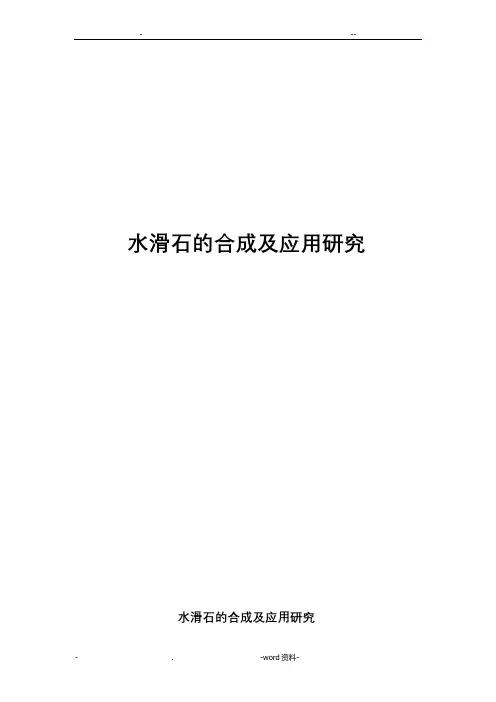
水滑石的合成及应用研究水滑石的合成及应用研究(北京化工大学应用化学)前言;介绍了水滑石类化合物的结构和性质,综述了水滑石类化合物的制备方法及其在催化材料、红外吸收材料、萦外阻隔材料、胆燃抑烟材料、热德定剂、生物医药材料、分离与吸附材料等方面的应用研究进展,并指出了当前水滑石类化合物制备与应用研究中存在的问题.关键词;水滑石类化合物层状双金属氢氧化物合成与制备应用Research and Application Progress of Hydrotalcite-like Compounds Abstract; Water talc is a kind of layered double hydroxyl compound metal oxides is the HT and HTLCs Because of its special crystal chemical properties, it has good thermal stability, adsorption and ion exchange sex, widely used in chemical,material, environmental protection and medicine, etc. There is introduces the structure and properties of hyrotalcite-like compounds, then reviews the research and application progress in its preparation and application as catalytic materials, infrared absorption materials, ultraviolet blocking materials, flame retardant and smoke suppressant materials, heat stabilizer, biomedical materials, separation and adsorption materials in recent years. The problems related to the preparation and application of hydrotalcite-like compounds are also discussedKey words : hydrotalcite-like compound, layered double hydroxides, preparation, application水滑石(Layered Double Hydroxides 简称LDHs),其化学组成[M2+1- xM3+x (OH)2]x+(Ax/nn-). mH2O(M2+,M3+分别代表二价和三价金属阳离子,下标x 指金属元素的含量变化,An- 代表阴离子),是一类典型的阴离子层状材料,其主体一般是由两种或两种以上金属的氢氧化物构成类水镁石层,层板内离子间以共价键连接,层间阴离子以弱化学键与层板相连,起着平衡骨架电荷的作用[1]. 水滑石类化合物为阴离子型层状化合物,层间具有可交换的阴离子,主要由水滑石(Hydrotalcite, HT)、类水滑石(Hydrotalcite-like compound, HTLC)和它们的插层化学产物—插层水滑石构成。
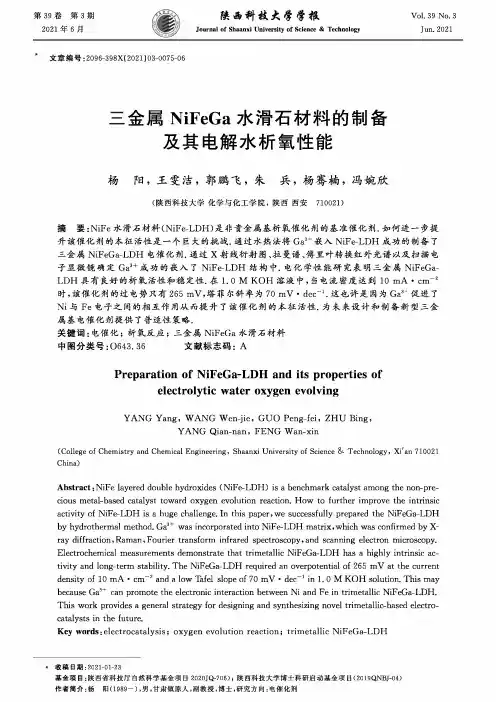
第39卷第3期2021年6月Vol.39No.3Jun.2021 Journal of Shaanxi University of Science&Technology文章编号:2096-398X(2021)03-0075-06三金属NiFeGa水滑石材料的制备及其电解水析氧性能杨阳,王雯洁,郭鹏飞,朱兵,杨骞楠,冯婉欣(陕西科技大学化学与化工学院,陕西西安710021)摘要:NiFe水滑石材料(NiFe-LDH)是非贵金属基析氧催化剂的基准催化剂.如何进一步提升该催化剂的本征活性是一个巨大的挑战.通过水热法将G#+嵌入NiFe-LDH成功的制备了三金属NiFeGa-LDH电催化剂.通过X射线衍射图、拉曼谱、傅里叶转换红外光谱以及扫描电子显微镜确定GF+成功的嵌入了NiFe-LDH结构中.电化学性能研究表明三金属NiFeGa-LDH具有良好的析氧活性和稳定性.在1.0M KOH溶液中,当电流密度达到10mA•cm"2时,该催化剂的过电势只有265mV,塔菲尔斜率为70mV•dec"1.这也许是因为Ga”促进了Ni与Fe电子之间的相互作用从而提升了该催化剂的本征活性.为未来设计和制备新型三金属基电催化剂提供了普适性策略.关键词:电催化;析氧反应;三金属NiFeGa水滑石材料中图分类号:0643.36文献标志码:APreparation of NiFeGa-LDH and its properties ofelectrolytic water oxygen evolvingYANG Yang,WANG Wen-jie,GUO Peng-fei,ZHU Bing,YANG Qian-nan,FENG Wan-xin(College of Chemistry and Chemical Engineering,Shaanxi University of Science&Technology,Xi'an710021 China)Abstract•NiFe layered double hydroxides(NiFe-LDH)is a benchmark catalyst among the non-pre-cious metal-based catalyst toward oxygen evolution reaction.How to further improve the intrinsic activity of NiFe-LDH is a huge challenge.In this paper,we successfully prepared the NiFeGa-LDH by hydrothermal method.Ga3+was incorporated into NiFe-LDH matrix,which was confirmed by X-ray diffraction,Raman,Fourier transform infrared spectroscopy?and scanning electron microscopy.Electrochemical measurements demonstrate that trimetallic NiFeGa-LDH has a highly intrinsic activity and long-term stability.The NiFeGa-LDH required an overpotential of265mV at the current density of10mA・cm-2and a low lafel slope of70mV・dec-1in1.0M KOH solution.This may because Ga3+can promote the electronic interaction between Ni and Fe in trimetallic NiFeGa-LDH.This work provides a general strategy for designing and synthesizing novel trimetallic-based electrocatalysts in the future.Key words:electrocatalysis;oxygen evolution reaction;trimetallic NiFeGa-LDH*收稿日期:2021-01-23基金项目:陕西省科技厅自然科学基金项目2020JQ-706);陕西科技大学博士科研启动基金项目(2019QNBJ-04)作者简介:杨阳(1989-),男,甘肃镇原人,副教授,博士,研究方向:电催化剂•76•陕西科蛊尢曆層报第39卷0引言氢能由于其高能量比、零碳排放和来源广泛等特点被认为是本世纪最具应用潜力的清洁能源口②.电解水制氢是一种清洁绿色的制氢手段冏.电解水制氢过程中涉及两个半反应,即在阴极部分发生析氢反应,在阳极部分发生析氧反应.然而,析氧反应不仅具有缓慢的反应动力学,而且需要较高的过电势来克服反应能垒,这严重阻碍了电解水产氢技术的发展⑷.因此,急需发展一种能够加快析氧反应速率、降低反应所需过电势且具有良好稳定性的电催化剂.贵金属氧化物IrO2和R u O2具有良好的析氧反应性能,但是其昂贵的成本以及储量稀少等缺点限制了这些催化剂的大规模使用.因此,科研工作者致力于发展含有地球富集元素的高活性电催化剂.近年来,人们发现了一系列含有地球富集元素Ni和Fe的新型析氧电催化剂®门.如戴宏杰等刀发现在轻度氧化的多孔碳纳米管上生长超薄的镰铁水滑石(NiFe-LDH)纳米片具有很高的析氧活性.然而,如何进一步提高NiFe-LDH的析氧活性是一个新的挑战.由于金属元素的协同效应对提升电催化剂的本征活性具有良好的效果,而且此效应并不局限于两种金属元素之间.因此,科研工作者尝试在NiFe-LDH中嵌入第三种金属元素以期提升该材料本征催化活性.例如,孙晓明等固在NiFe-LDH中掺入V提升了该催化剂的本征催化活性.这是因为V的嵌入促进了Ni与Fe之间的协同效应并且调整了整个催化剂的电子结构•但是这些元素对该材料本征活性的提升依旧有限,这就要求科研工作者探索新的金属元素,以期能够大幅度提升NiFe-LDH的本征催化活性.地球富集元素Ga具有多种氧化态.最常见的GF+是路易斯酸阳离子,能够改变析氧反应过程中水分子的亲核能力和质子转移能力,从而促进多电子氧化还原阳离子Ni和Fe电子之间的相互作用,最终提升催化剂的本征活性•同时,氢氧化傢属于两性氢氧化物.这种性质有可能导致含有Ga元素的LDH基催化剂在析氧反应过程中由于傢的易刻蚀性而在催化剂中原位产生缺陷和空位,从而提升催化剂的本征活性.此外,Fe元素对NiFe-LDH的催化性能有很大的提升能力,而GF+与FM+具有类似的电子结构.因此6云+对催化剂的本征活性也许有提升作用.本文采用水热法成功的把GF+嵌入NiFe-LDH合成了三金属NiFeGa-LDH电催化剂.从电化学表征数据分析,三金属NiFeGa-LDH比双金属NiFe-LDH具有更好的析氧性能和优异的稳定性.此工作为未来设计和合成更高催化性能的金属基电催化剂提供了普适性策略.1实验部分1.1药品与仪器1.1.1实验药品实验所用到的药品及规格如表1所示.表1药品、规格及生产厂家药品名称规格生产厂家六水合硝酸镰(II)99.99%上海阿拉丁生化科技股份有限公司水合硝酸傢(IH)99.9%上海阿拉丁生化科技股份有限公司氟化钱98%上海阿拉丁生化科技股份有限公司尿素99%上海阿拉丁生化科技股份有限公司四水合氯化亚铁(II)98%上海麦克林生化科技有限公司氢氧化钾90%上海麦克林生化科技有限公司Nafion溶液5wt%西格玛奥德里奇(上海)贸易有限公司乙醇99.7%国药集团化学试剂有限公司1.1.2仪器X射线衍射仪(Bruker D8,德国);拉曼光谱仪(DXR,美国);傅里叶变换红外光谱仪(Bruker VECTOR-22,德国);场发射扫描电子显微镜(Zeiss Sigma300,德国);纯水机(UlupureUPR-III-10T,中国).1.2NiFeGa-LDH和NiFe-LDH的制备将0.1745g Ni(NO3)2•6H2O,0.0298g FeCl2•4H2O,0.0384g Ga(NO3)3•丄巴0,和0.1480g NH4F溶于20mL的超纯水中,再加入0.2402g(NH2)2CO充分溶解,配成前驱体溶液.取15mL前驱体溶液转移到含聚四氟乙烯内衬(25mL)的不锈钢高压反应釜中,在120°C的鼓风干燥箱中保温6h.自然冷却至室温后,依次用超纯水、乙醇在4000rpm的转速下离心洗涤三次,每次离心5min,随后在60°C的真空干燥箱中干燥过夜,得到的产物即为NiFeGa-LDH.NiFe-LDH的合成过程与上述流程类似,区别在于制备前驱体溶液时不加入傢源.1.3材料电化学性能表征1.3.1制备工作电极称取5mg催化剂置于600“L超纯水、400//L 乙醇和20“L5wt%Nafion的混合溶液中,超声至少30分钟至分散均匀.用移液枪吸取5“L悬浮液滴在已抛光好的玻碳电极上,在红外灯下烤干.在制备工作电极过程中,使用的玻碳电极均使用低速抛光机在0.05/zm的A12O3浆体下抛光5min.1.3.2电化学性能测试第3期杨阳等:三金属NiFeGa水滑石材料的制备及其电解水析氧性能•77•电化学性能测试选用CHI760E型电化学工作站.实验采用三电极系统进行测试,氧化汞电极(Hg/HgO)为参比电极,钳丝为对电极,负载了催化剂的玻碳电极作为工作电极*电解液为 1.0M KOH溶液,测试温度为室温.所测数据的电势均转换为可逆氢电极(RHE),具体计算公式如式(1)所示;ERHE=EHg/Hgo+°・059XpH+0.098V(1)式(1)中:1.0M KOH溶液的pH为13.71,即:E rhe=EHg/Hgo+0*907V在电化学测试过程中,全程通入高纯氧气.循环伏安曲线(CV)的电势扫描范围为1.1〜1.7V (w.RHE),扫速为5mV・s3所有测得的CV曲线均经过溶液电阻校正,校正水平为95%.通过CV 法测得双电层电容(CR,测试条件如下:扫描范围为0.2〜0.3V(vs.Hg/HgO);扫速分别为20mV・s-1、40mV•s_1、60mV・s_1、80mV•s_1400mV-s_1和120mV・s'1.文中所有的电流密度均依据工作电极的几何面积(0.196cm")计算.最后,在电流密度为10mA・cnT?时,使用计时电位法对NiFeGa-LDH进行时长为6h的稳定性测试.2结果与讨论2,1LDH的表征通过X射线衍射仪对样品进行物相和晶体结构分析,其结果如图1所示.NiFeGa-LDH粉末样品的衍射峰与LDH材料的特征峰吻合(JCPDS No.40-0215)3门,表明成功制备了NiFeGa-LDH 且具有较高的结晶度,但随着前驱体溶液中Ga离子的掺入,位于23。
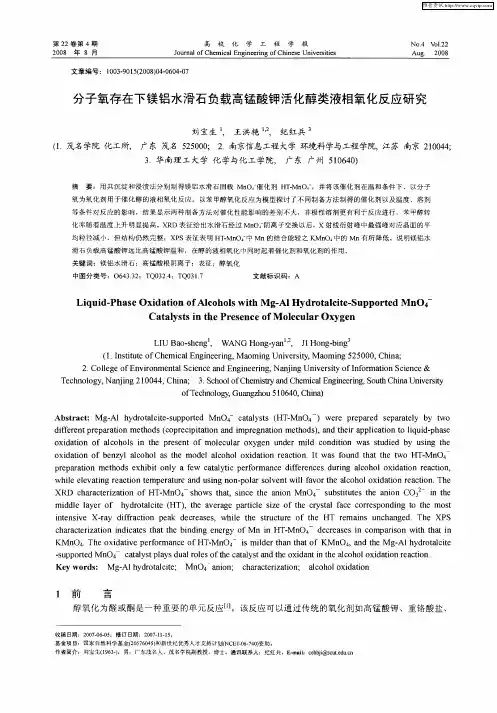

水滑石是一类具有特殊结构的层状无机材料。
具有独特的结构和性能,在离子交换、吸附分离、催化、医药等领域得到广泛应用。
水滑石类材料主要包括水滑石(Hydrotalcite,简称HT)及水滑石类化合物(Hy-drotalcite-likecompounds,简称HTlc)。
其结构既具有层板上阳离子的同晶取代性,又具有层间阴离子的可交换性[1]。
由于其独特的结构特性、组成及孔结构的可调变性以及优良的催化性能,在吸附、催化领域中占有重要位置,使其在催化、工业、医药等方面具有广阔的应用前景。
1水滑石的组成及结构特征典型的水滑石Mg6Al2(OH)16CO3・4H2O是一种天然存在的矿物。
水滑石与水镁石(Mg(OH)2)的结构类似,水镁石由Mg(OH)2八面体相互共边形成层状化合物[2],层与层之间对顶地叠在一起,层间通过氢键缔合。
当水镁石层状结构[3]中的Mg2+部分被半径相似的阳离子(如Al3+、Fe3+、Cr3+)取代时,会导致层上正电荷的积累,这些正电荷被位于层间的负离子平衡,在层间的其余空间,水以结晶水的形式存在。
当Mg2+和Al3+被半径相似的2价或3价阳离子同晶取代,或CO32-被其他阴离子取代,即形成HTlc。
水滑石类化合物是一类层柱状化合物,其理想组成为M(Ⅱ)6M(Ⅲ)2(OH)16CO32-・4H2O,M(Ⅱ)为2价金属阳离子(如Mg2+,Zn2+,Cu2+,Ni2+等),M(Ⅲ)为3价金属阳离子(如Al3+,Fe3+,Cr3+等)。
层间阴离子CO32-可被NO3-和Cl-等简单的无机阴离子取代,也可被体积较大的同多和杂多金属含氧酸盐取代,还可以被不同体积的有机阴离子替代,从而得到另一种水滑石类化合物,称之为柱撑水滑石。
水滑石类化合物的特殊结构使其具有特殊的性能。
(1)层板化学组成的可调控性;(2)层间离子种类及数量的可调控性;(3)晶粒尺寸及其分布的可调控性;(4)低表面能。
类水滑石具有和水滑石相同的结构,差别在于层上阳离子和层间阴离子的种类和数量,二者统称为水滑石。
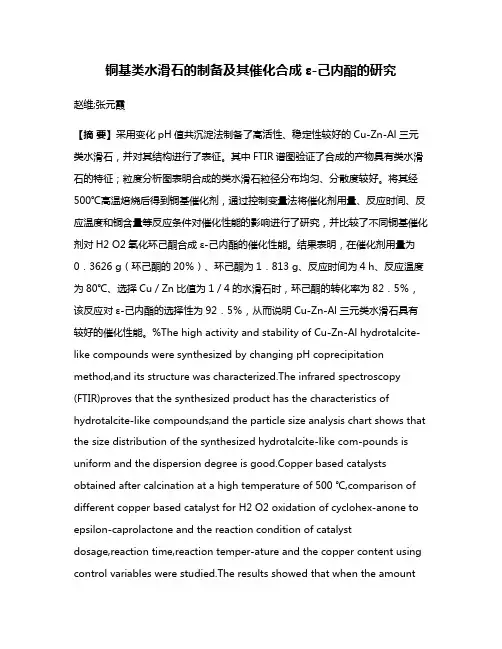
铜基类水滑石的制备及其催化合成ε-己内酯的研究赵维;张元霞【摘要】采用变化pH值共沉淀法制备了高活性、稳定性较好的Cu-Zn-Al三元类水滑石,并对其结构进行了表征。
其中FTIR谱图验证了合成的产物具有类水滑石的特征;粒度分析图表明合成的类水滑石粒径分布均匀、分散度较好。
将其经500℃高温焙烧后得到铜基催化剂,通过控制变量法将催化剂用量、反应时间、反应温度和铜含量等反应条件对催化性能的影响进行了研究,并比较了不同铜基催化剂对H2 O2氧化环己酮合成ε-己内酯的催化性能。
结果表明,在催化剂用量为0.3626 g(环己酮的20%)、环己酮为1.813 g、反应时间为4 h、反应温度为80℃、选择Cu/Zn比值为1/4的水滑石时,环己酮的转化率为82.5%,该反应对ε-己内酯的选择性为92.5%,从而说明Cu-Zn-Al三元类水滑石具有较好的催化性能。
%The high activity and stability of Cu-Zn-Al hydrotalcite-like compounds were synthesized by changing pH coprecipitation method,and its structure was characterized.The infrared spectroscopy (FTIR)proves that the synthesized product has the characteristics of hydrotalcite-like compounds;and the particle size analysis chart shows that the size distribution of the synthesized hydrotalcite-like com-pounds is uniform and the dispersion degree is good.Copper based catalysts obtained after calcination at a high temperature of 500 ℃,comparison of different copper based catalyst for H2 O2 oxidation of cyclohex-anone to epsilon-caprolactone and the reaction condition of catalystdosage,reaction time,reaction temper-ature and the copper content using control variables were studied.The results showed that when the amountof catalyst is 0.362 6 g(20%of cyclohexanone),cyclohexanone is 1.813g,reaction time is 4 h, the reaction temperature is 80 ℃and Cu/Zn ratio of hydrotalcite is 1/4,the conversion of cyclohexanone rate was 82.5%,the selectivity of Epsilon-caprolactone was 92.5%.It is proved Cu-Zn-Al hydrotalcite-like compounds has good catalytic performance.【期刊名称】《应用化工》【年(卷),期】2016(045)005【总页数】4页(P901-904)【关键词】类水滑石;共沉淀法;铜基催化剂;ε-己内酯【作者】赵维;张元霞【作者单位】咸阳师范学院化学与化工学院,陕西咸阳 712000;咸阳师范学院化学与化工学院,陕西咸阳 712000【正文语种】中文【中图分类】TQ225;O631水滑石(LDHs)是一类具有独特结构和性质的无机材料,自然界的水滑石数量很少,而类水滑石化合物(HTLc)是在水滑石化合物的基础上,用其他二价和三价金属离子取代层板上镁离子和铝离子,从而形成了一类新的化合物[1]。
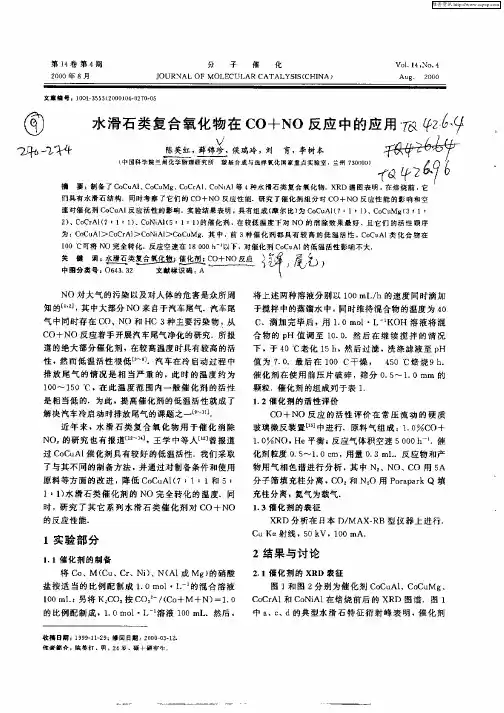
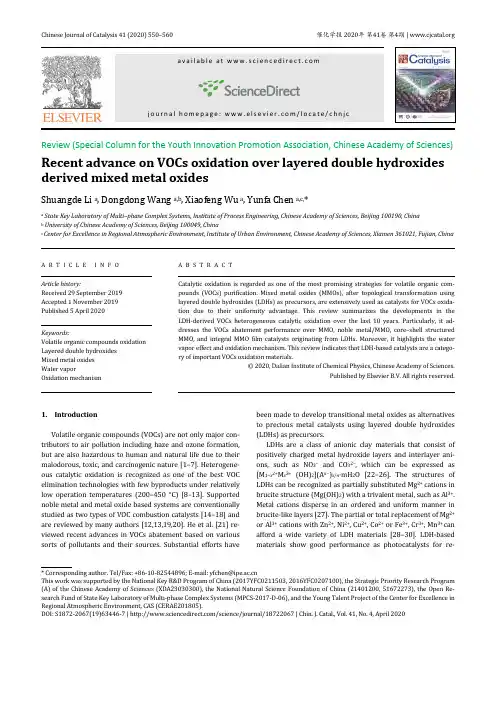
Chinese Journal of Catalysis 41 (2020) 550–560催化学报 2020年 第41卷 第4期 | a v a i l ab l e a t w w w.sc i e n c ed i re c t.c o mj o u r n a l h o m e p a g e : w w w.e l s e v i e r.c o m /l o c a t e /c h n j cReview (Special Column for the Youth Innovation Promotion Association, Chinese Academy of Sciences)Recent advance on VOCs oxidation over layered double hydroxides derived mixed metal oxidesShuangde Li a , Dongdong Wang a,b , Xiaofeng Wu a , Yunfa Chen a,c,*a State Key Laboratory of Multi–phase Complex Systems, Institute of Process Engineering, Chinese Academy of Sciences, Beijing 100190, China bUniversity of Chinese Academy of Sciences, Beijing 100049, Chinac Center for Excellence in Regional Atmospheric Environment, Institute of Urban Environment, Chinese Academy of Sciences, Xiamen 361021, Fujian, ChinaA R T I C L E I N F OA B S T R A C TArticle history:Received 29 September 2019 Accepted 1 November 2019 Published 5 April 2020Catalytic oxidation is regarded as one of the most promising strategies for volatile organic com-pounds (VOCs) purification. Mixed metal oxides (MMOs), after topological transformation using layered double hydroxides (LDHs) as precursors, are extensively used as catalysts for VOCs oxida-tion due to their uniformity advantage. This review summarizes the developments in the LDH-derived VOCs heterogeneous catalytic oxidation over the last 10 years. Particularly, it ad-dresses the VOCs abatement performance over MMO, noble metal/MMO, core–shell structured MMO, and integral MMO film catalysts originating from LDHs. Moreover, it highlights the water vapor effect and oxidation mechanism. This review indicates that LDH-based catalysts are a catego-ry of important VOCs oxidation materials.© 2020, Dalian Institute of Chemical Physics, Chinese Academy of Sciences.Published by Elsevier B.V. All rights reserved.Keywords:Volatile organic compounds oxidation Layered double hydroxides Mixed metal oxides Water vaporOxidation mechanism1. IntroductionVolatile organic compounds (VOCs) are not only major con-tributors to air pollution including haze and ozone formation, but are also hazardous to human and natural life due to their malodorous, toxic, and carcinogenic nature [1–7]. Heterogene-ous catalytic oxidation is recognized as one of the best VOC elimination technologies with few byproducts under relatively low operation temperatures (200–450 °C) [8–13]. Supported noble metal and metal oxide based systems are conventionally studied as two types of VOC combustion catalysts [14–18] and are reviewed by many authors [12,13,19,20]. He et al. [21] re-viewed recent advances in VOCs abatement based on various sorts of pollutants and their sources. Substantial efforts havebeen made to develop transitional metal oxides as alternatives to precious metal catalysts using layered double hydroxides (LDHs) as precursors.LDHs are a class of anionic clay materials that consist of positively charged metal hydroxide layers and interlayer ani-ons, such as NO 3– and CO 32–, which can be expressed as [M 1−x 2+M x 3+ (OH)2](A n −)x /n ·mH 2O [22–26]. The structures of LDHs can be recognized as partially substituted Mg 2+ cations in brucite structure (Mg(OH)2) with a trivalent metal, such as Al 3+. Metal cations disperse in an ordered and uniform manner in brucite-like layers [27]. The partial or total replacement of Mg 2+ or Al 3+ cations with Zn 2+, Ni 2+, Cu 2+, Co 2+ or Fe 3+, Cr 3+, Mn 3+ can afford a wide variety of LDH materials [28–30]. LDH-based materials show good performance as photocatalysts for re-* Corresponding author. Tel/Fax: +86-10-82544896; E-mail: yfchen@This work was supported by the National Key R&D Program of China (2017YFC0211503, 2016YFC0207100), the Strategic Priority Research Program (A) of the Chinese Academy of Sciences (XDA23030300), the National Natural Science Foundation of China (21401200, 51672273), the Open Re-search Fund of State Key Laboratory of Multi-phase Complex Systems (MPCS-2017-D-06), and the Young Talent Project of the Center for Excellence in Regional Atmospheric Environment, CAS (CERAE201805).DOI: S1872-2067(19)63446-7 | /science/journal/18722067 | Chin. J. Catal., Vol. 41, No. 4, April 2020Shuangde Li et al. / Chinese Journal of Catalysis 41 (2020) 550–560 551newable energy production [23], photoelectrochemical water splitting [31], supercapacitors [32], denitrification [33–35], CO 2 capture [36,37], etc. based on their unique layered structure, compositional flexibility, and surface defect design.The thermal treatment of these materials at specific tem-peratures provide a facile route to obtaining mixed metal ox-ides (MMO) presenting several unique properties, such as large surface areas and porosities, high thermal stabilities, and ex-cellent metal oxides dispersion, as well as basic properties [38–41]. The synergistic effects between different metal oxides are one of the most interesting properties achieved using LDH precursors [29,42]. Recently, authors have devoted considera-ble attention to heterostructured interfaces by the topological transformation of LDHs due to the existing edge and corner sites with few coordinative unsaturated active sites, which will induce enhanced performance [43–45]. In the past few years, there have been several reviews based on LDH precursors and their thermal treatment involving heterogeneous catalysis for various reactions, including environmental pollution control and organic transformations [38–41]. In this review, we mainly focus on the catalytic oxidation of VOCs over LDH-derived cat-alysts classified under MMO catalyst, noble metal/MMO cata-lyst, core-shell MMO catalyst, and integral MMO catalyst within the last 10 years (Fig. 1). The effect of water vapor on the activ-ity and catalytic mechanism are also highlighted. Expectedly, this review will attract more attention toward LDH-derived catalysts for VOCs elimination.2. Catalytic oxidation of VOCs over LDH-derived catalysts 2.1. VOC catalysts based on MMOMany kinds of active transition metals (e.g., Mn, Fe, Co, Ni, Cu, Zn, Ti, and Zr) can be incorporated into the host layer of LDHs with one, two, or more transition elements together. The calcination of these kinds of LDHs at different temperatures under air exposure mainly affords MMO in solid solution or spinel style, which would exhibit good catalytic activity toward VOCs oxidation, including benzene series, oxygen-VOCs, and CVOCs. The cation composition, metal molar ratio of the host layer, preparation method, and calcination temperature during the preparation of the LDHs precursors will influence the tex-tural properties of the resulting catalysts, which will be antici-pated to induce varied catalytic activities. Table 1 partly sum-marizes publications in recent years on transition metal-based catalysts for the catalytic oxidation of VOCs derived from LDH precursors.The substitution of Mg 2+ in MgAl LDH is expected to induce distinctly different VOC oxidation performances and was sys-tematically investigated by Genty et al. [61]. The different redox properties ascribed to the nature of bivalent cations play key roles in ensuring the catalytic efficacy. The catalytic activity toward toluene oxidation has been confirmed to be in the order of Mn 6Al 2HT > Co 6Al 2HT = Cu 6Al 2HT > Fe 6Al 2HT > Ni 6Al 2HT >> Zn 6Al 2HT > Mg 6Al 2HT after calcination at 500 °C. It can be con-cluded that divalent cations play key roles in ensuring the VOC oxidation efficiency. Besides, the valence states of surface active phases, which correspond to reducibility and desirable surface exposed defects, are quite well related to the VOC oxidation activity. Mo et al. designed a Co II 2.8Co III 1 LDH nanostructure via a facile topochemical transformation route under a dynamic oxygen atmosphere and proved that rich surface Co 3+ ions are crucial for enhanced benzene/toluene oxidation performance [46]. Rich Co 3+ nanocatalysts exhibited a higher catalytic activ-ity with 99% conversation (temperature T 99(benzene) = 210 °C and T 99(toluene) = 220 °C) than that exhibited by low levels of Co 3+ based nanocatalyst from CoAlLDH prepared by a tradition-al coprecipitation method.The mixed oxides normally present better performance than the individual oxide does for the cooperative effects, which induces changes in their structure and redox properties. Jiratova et al. [52] analyzed the effect of the cation composition on ethanol oxidation derived from LDHs with M II = Cu, Co, Ni, CuNi, CuCo, CoNi, and M III = Mn or Al by the coprecipitation of nitrate solutions. The Mn-containing ternary mixed oxide cata-lysts are more active than the ternary Al-containing and the binary Cu-Mn, Co-Mn, and Ni-Mn catalysts are. The CuNiMn mixed oxide catalysts exhibit the best oxidation activity with T 90 = 154 °C. The catalytic activities are positively related to increasing the amount of easily reducible components. Li et al. [53] reported CoCuAl spinel oxides for benzene oxidation, pre-pared from CoCuAlCO 3LDHs synthesized by the coprecipitation method, followed by calcination at 500 °C. (Co, Cu)(Co,Al)2O 4 spinel with low Cu loading exhibits increased total conversion activity with T 90 = 306 °C under 36000 mL ·g –1·h –1 due to a strong interaction between Cu 2+ and Co 3+ active sites; however, the activity decreases with high Cu loading toward the for-mation of bulk CuO separated from the spinel. Cu/Mn/Mg/Al and Co/Mn/Mg/Al mixed oxides were obtained following the calcination of hydrotalcite precursors. The mixed active phases from Cu-Mn or Co-Mn will optimize the physicochemical and catalytic properties compared with the case involving only the Mn active phase. Co/Mn/Mg/Al catalysts are the most active toward the degradation of VOCs following the order of butanol < ethanol < toluene, which is related to the amorphous phases and redox cycles for the cooperative effect between Co and Mn [62]. Mo observed the significant promotional effect of Ce on Mn-Al oxide catalysts for the catalytic activity of benzene. Theenhanced activity is ascribed to the electronic transfer betweenFig. 1. Assortment and advantages of LDH-derived catalysts for the catalytic oxidation of VOCs.552Shuangde Li et al. / Chinese Journal of Catalysis 41 (2020) 550–560CeO2and MnO x, via a redox pathway: Ce4+–Mn3+↔Ce3+–Mn4+ [47].Li et al. [48,49] constructed a series of Cu or Ni doping CoA-lO catalysts by the coprecipitation of their corresponding LDHs following calcination at 400 °C and systematically evaluated the relationship of the molar ratio (Cu/Ni:Co) within the host layer and their benzene abatement performances (Fig. 2). Cu x Co3−x AlO catalysts consist of CuO and Co3O4 mixed phases, while Ni x Co3−x AlO catalysts consist of a Co3O4phase with the absence of a NiO phase, revealing the formation of a solid solu-tion. The benzene oxidation activities all exhibit volcano shapes, implying the presence of Cu or Ni doping. It can be con-cluded that the doping will induce a change in the reducibility and surface oxygen species of the catalysts through the coordi-nation of Cu/Ni with Co. Zhao et al. [51] investigated the influ-ence of Co/Al molar ratios and the calcination temperature on acetone oxidation. The 5:1 CoAlO-300 catalyst performed effi-ciently in acetone oxidation with T90 = 225 °C. The Co/Al molarTable 1Summary of publications in recent years on transition metal-based catalysts for the catalytic oxidation of VOCs.Catalyst with cal cination temperature Method VOCsSpace vel ocity(mL·g−1·h−1)Temperature(°C)Conversion(%)Refs.Co II Co III AlO-400 Coprecipitation und er dynamic oxygen100 ppm benzene 60000 210 99 [46] Co II Co III AlO-400 Coprecipitation und er dynamic oxygen191 ppm toluene 60000 220 99 [46] Ce/MnAlO-400 Coprecipitation-hydrothermal 100 ppm benzene 60000 210 90 [47] Cu0.5Co2.5AlO-400 Coprecipitation 100 ppm benzene 60000 290 90 [48] NiCo2AlO-400 Urea coprecipitation 1000 ppm benzene 60000 227 90 [49]CoMn2Al-550 NH4OH coprecipitation-hydrothermalmethod100 ppm benzene 60000 208 90 [50]5:1CoAlO-300 Coprecipitation 1000 ppm acetone 33000 225 90 [51] CuNiMnO-500 Coprecipitation 750 ppm ethanol 20000 154 90 [52] (Co,Cu)(Co,Al)2O4-500 Coprecipitation 516 ppm benzene 36000 306 90 [53] Co6Al2HTMW-500 Microwaves 1000 ppm toluene 60000 275 90 [54] MnCuAl-450 Coprecipitation 800 ppm toluene 75000 297 100 [55] Co3O4-500 Coprecipitation 1000 ppm 1,2-dichl oroethane35294 300 90 [56] CuMgAl-550 Coprecipitation 1000 ppm trichl oroethyl ene 35294 500 90 [57] CuNiAl-550 Coprecipitation 1000 ppm trichl oroethyl ene 35294 530 90 [57] Pd/Co3AlO-500 Coprecipitation 800 ppm toluene 30000 230 90 [58]PdCoAl-600 Urea hydrothermal foll owingimpregnation1000 ppm toluene 60000 226 90 [59]Pd0.5/Cu(5)-Mg-Al-500 Coprecipitation foll owing impregnation4% methanol 12000 220 90 [60]Fig. 2. (A, B) XRD patterns of CoCuAlO and benzene conversion vs temperature [48]; (C, D) XRD patterns of CoNiAlO and benzene conversion vs tem-perature [49].Shuangde Li et al. / Chinese Journal of Catalysis 41 (2020) 550–560553ratios influence the activity by affecting the surface Co3+/Co2+ molar ratio and low-temperature reducibility.Evidently, the preparation method influenced the physico-chemical properties of the LDHs. The MgAl and CoAl hy-drotalcite-derived catalysts were evaluated based on their ac-tivity toward toluene oxidation using co-precipitation, micro-wave-assisted, and ultrasound-assisted methods. Among the three sample groups, microwave-assisted catalysts, MgAlHTMW500 and CoAlHTMW500, exhibited the highest activity with T90 ≈ 275 and 408 °C at 60000 mL·g–1·h–1 due to the modification of the structural characteristics (surface area and morphology), together with the reducibility [54]. Actually, microwave-assisted catalysts possess larger surface areas and smaller crystallite sizes with rod morphology compared to those of co-precipitation and ultrasound-assisted catalysts. The application of Co-Mn mixed oxides for the degradation of tolu-ene and 2-propanol with the influence of the synthesis method were also systematically characterized [42]. The existence of a cooperative effect between the Co and Mn oxides synthesized by coprecipitation, in comparison with those prepared by the auto combustion method, enhances the oxygen mobility and the redox properties of the material due to the formation of a solid solution. 18O isotope exchange shows that oxygen mobility plays a more important role than the redox property does in the VOCs oxidation. Co-Mn-Mg-Al oxides synthesized by au-to-combustion and co-precipitation techniques were employed to evaluate the influences of the oxygen storage capacity and oxygen mobility [63]. The cooperative effect between Co and Mn through co-precipitation will promote the redox properties and oxygen mobility, which would improve the catalytic activi-ty for the mixture of toluene and 2-propanol.Mo et al. [46] reported well-defined CoAlLDH precursors with different self-assembled 3D nanostructure morphologies affected by different ammonia-releasing reagents and solvents through the homogeneous co-precipitation method. The re-sultant catalysts show varied physical and chemical character-istics, such as acid sites distribution, acidity, surface area, and surface element composition, which were further correlated systematically to their physicochemical properties and catalytic activities. The CoAlO sample with uniform pompom-like struc-tures, synthesized in ethanol solvent with urea as a precipitant, exhibits the best activity with T99 (benzene)= 230 °C, which is ascribed to a high number of Lewis acid sites beneficial for VOCs adsorption. Alkali doping has a positive effect on the cat-alytic activity by neutralizing acidic centers and modifying the surface electronic property. A K-modified CoMnAl mixed oxide catalyst (0 wt%–3 wt%) was investigated for the total oxida-tion of toluene and ethanol by Jiratova et al. [64]. The surface acid–base properties of the catalyst were influenced under low K additions, while Mn oxides segregated from the original spi-nel-like phase at a high K doping, which caused significant changes in the VOCs oxidation.The catalysts synthesized through “memory effect” of LDHs are thought to present interesting catalytic behaviors toward VOC oxidation due to their representative structures. Genne-quin synthesized Co supported on calcined Mg-Al LDH catalysts using the “memory effect” and reported that the “memory ef-fect” was directly related to the toluene elimination activity [65]. The reconstruction of the Mg-Al oxide supports can in-duce the formation of a high quantity of active surface Co spe-cies with a high specific area and high reducibility, which cor-responds to the deep oxidation of toluene. Therefore, it can be concluded that the reconstruction of the LDHs positively influ-ences the interaction between Co species and the support.Meanwhile, the catalytic activities with different calcination temperatures mainly depend on the thermal treatment tem-perature of the catalysts. The calcination temperature influ-ences the crystallinity of the LDH-derived catalysts, leading to the divergence of reducibility, which causes different VOC oxi-dation activities. Palacio et al. [55] prepared ZnCuAl and MnCuAl catalysts by a co-precipitation method and evaluated the effects of calcination at 450 and 600 °C. ZnCuAl is an amor-phous phase catalyst calcined at 450 °C and subsequently transferred to Cu and Zn oxides supported on alumina at 600 °C treatment. The MnCuAl samples calcined at 450 °C exhibit a spinel phase with lower crystallinities than those of the sam-ples calcined at 600 °C. After 450 °C treatment, MnCuAl catalyst presented the highest catalytic performance with 100% tolu-ene conversion at 297 °C because it had the best textural and reductive properties. The effects of the calcination temperature on the textural properties and catalytic activity over the CoMn2AlO catalyst were further investigated. The as-prepared CoMn2AlO-550 sample exhibited higher benzene catalytic ac-tivity with T90 = 208 °C than that of CoMn2AlO-450, which was due to the formation of a solid solution with low-temperature reducibility, together with the high surface area and rich oxy-gen vacancies [50].The development of the gas-phase oxidation of chlorinated VOCs with comparable activity over transition metal oxides catalysts is currently underway. Rivas prepared nanocrystal-line Co3O4by 5 methods, namely calcination of the precursor salt, solid-state reaction, precipitation-oxidation, precipitation, and sol-gel [56]. It can be concluded that the catalysts prepared through LDH precursors derivation exhibited the lowest tem-peratures with 90% 1,2-dichloroethane oxidation at 300 °C. Small crystallites affording more easily accessible active sites for oxygen species adsorption and improved redox properties chiefly contribute to the high activity, which is not the case for the highly crystalline Co3O4catalysts from other preparation methods. Additionally, the surface Lewis acidity plays a rele-vant catalytic role in promoting 1,2-dichloroethane conversion. Cu/(Mg or Ni)/Al mixed oxides derived from hydrotalcite-like compounds have also been evaluated for the trichloroethylene abatement. Cu-based oxides improve the catalytic activity, par-ticularly at low temperatures, in comparison with those with-out Cu. This is due to the important redox properties of Cu and the synergistic effect between Cu and Ni. The CuMgAl catalysts are stable at 400 °C at least for 50 h, which indicate that Cu ions are active and stable for trichloroethylene oxidation.2.2. VOCs catalysts based on noble metal/MMOExcellent low-temperature oxidation activities with long-term operating stability are essential in practical applica-554 Shuangde Li et al. / Chinese Journal of Catalysis 41 (2020) 550–560tion for VOCs decomposition. Although various MMO through the calcination of LDHs exhibit good catalytic performance to-ward VOCs abatement, the low-temperature activity, initiation temperature, and durability still have gaps with supported noble metal catalysts. For example, CoAlCeO catalyst exhibits outstanding efficiency toward toluene and butanone oxidation considering both the activity and byproduct in comparison with those of commercial Pd-based materials, such as Pd/Al 2O 3; however, the low-temperature activity of T 50% is still much worse than that of the Pd/Al 2O 3 samples [66]. This presents a good method for preparing supported noble metal catalysts through preloading noble precursors on LDH substrates (the schematic diagram is shown in Fig. 3), which is expected to induce the most desirable activity and stability with the fol-lowing unique advantages: (1) uniform dispersion of the noble metal nanoparticles will be influenced by the textural proper-ties of the support; (2) interaction of the support and noble metal will immobilize noble active species leading to thermal stability; (3) noble metals oxidation states will be affected, which will favor the low-temperature activity for VOCs oxida-tion.Basile et al. [67] investigated the synthesis and thermal evolution of Ru/Rh-MgAl LDHs and will favor the well-dispersed and stable noble metal particles, which results in higher activities than those of wet impregnation catalysts. The different loading approaches of noble active species on LDHs result in significantly different catalytic activities. Li et al. [58] prepared Pd/Co 3AlO catalysts derived from Pd loading CoAlLDH by impregnation (IMP), wet ion exchange (WIE), or directly at the coprecipitation stage (COP). All the Pd/Co 3AlO catalysts derived from LDHs exhibit high toluene oxidation activities compared with those prepared by the traditional thermal combustion method. Thus, LDH-derived Pd/Co 3AlO catalysts exhibit high surface areas, small mean crystallite sizes of supports, and highly dispersed PdO particles. The best activ-ity of Pd/Co 3AlO (COP) with T 90 = 230 °C and few byproducts contributed to the easy reducibility and high oxygen vacancies owing to the strong synergistic effect between Co 3O 4 and PdO, as shown in Fig. 4 [58].The noble metal species can also play an important role in the VOCs decomposition activity. Zhao prepared different noble metal loading spinel oxides through the calcination of Ag, Pt, and Pd immobilized on CoAlLDH for toluene combustion. The Pd–CoAlO catalyst exhibited the highest catalytic activity due to the interaction between the PdO phase and the CoAlO support, which favors the highest low-temperature reducibility, the most abundant surface Co 3+, and surface adsorbed oxygen spe-cies through the cooperative effect [59]. The species of the LDH substrates that are used for noble metal loading significantly affect the performance of the VOCs oxidation. Pd-MgAlO and Pd-CoAlO catalysts have been prepared for the comparison of their catalytic activities [59]. The activity energy of Pd-MgAlO (112.5 kJ mol -1) is much higher with a poor catalytic activity than that of Pd–CoAlO (49.5 kJ mol -1) with superior toluene combustion performance, which confirms that the LDH pre-cursors play significant roles in the VOCs oxidation, and that Co from the CoAlO support is involved in the reaction process. Furthermore, 0.5 wt% Pd-doped (Cu,Mn)-Mg-Al metal oxide catalysts were prepared by the incipient wetness impregnation of Pd ions on their corresponding LDH precursors following calcination at 500 °C. The activity toward methanol oxidation decreased in the following order: Pd0.5/Cu(0.5)-Mg-Al-600 > Pd0.5/Cu-Mn-Mg-Al-600 > Pd0.5/Mg-Al-600 > Pd0.5/ Mn-Mg-Al-600 > Cu-Mn-Mg-Al > Cu(0.5)-Mg-Al > Mn-Mg-Al > Mg-Al, which confirms that the (1) calcined Cu-containing hy-drotalcite catalysts are more active than the Mn-containing hydrotalcite catalysts are; (2) incorporation of Pd significantly improves the methanol low-temperature activity due to the hydrogen dissociation and spill-over on Pd with the low-temperature reduction peaks splitting into two peaks [60]. 2.3.VOCs catalysts based on core-shell MMOFig. 3. Schematic diagram of the preparation of noble metal/MMO cat-alysts for VOCs oxidation.Fig. 4. Temperature-programmed curves of (A) toluene conversion and (B) the yield of the benzene byproduct over different Pd/Co 3AlO cata-lysts and Co 3AlO sample [58].Shuangde Li et al. / Chinese Journal of Catalysis 41 (2020) 550–560 555Two-dimensional LDH-derived MMO catalysts exhibit poor control over the particle size, morphology, and crystalline ori-entation, which can restrict their catalytic efficiency. Recently, hierarchical flower-like core-shell structured MMO derived from LDHs have evoked remarkable interest for their excellent performance in catalytic oxidation [68] and CO 2 methanation [69] due to their high surface areas, high dispersion of active phases, and their synergistic effect. Hierarchical flower-like core-shell structured mixed metal oxides can be reproducibly prepared by in situ growth of a two-dimensional LDH precursor on amorphous Al 2O 3 [70], Fe 2O 3 [71,72], SiO 2 [73], and TiO 2 [74] spheres or ZIF-67 [75], followed by calcination, and the sche-matic of the preparation process is shown in Fig. 5. Li’s group prepared hierarchical flower-like core–shell structured CoZ-nAlO and CoCuAlO supported on alumina via an in situ growing LDH precursor route, which exhibited high dispersion of Co species due to well-developed three-dimensional flower-like mixed metal oxides platelets [70,76].Wang reported a two-step method to construct a 3D hier-archical NiCo 2O 4/NiO nanocage through a partial in situ trans-formation of ZIF-67 into Co-NiLDH yolk-shelled structures fol-lowing calcination [75]. The CoNi-6h-350 sample showed much higher toluene oxidation activity with lower T 90 of 229 °C due to the abundant surface high valence Co ions owing to the novel hierarchical nanostructures.Zhao et al. [77] successfully prepared hierarchical core-shell Al 2O 3@Pd-CoAlO (Pd-CoAlO-Al) microspheres and Pd-CoAlO catalysts lacking core-shell structures (Pd-CoAlO-S), and ex-amined their toluene abatement performance. Fig. 6 indicates that they all show hierarchical microsphere structures. The results in Fig. 6 and Table 2 reveal that the core-shell Pd-CoAlO-Al exhibits significantly better catalytic efficiency with the lower T 90 temperature of 207 °C and higher TOF Co and TOF Pd values than those of the Pd-CoAlO-S catalysts without core–shell structures with T 90 of 229 °C. The discrepancy on the catalytic activity is probably due to the homogeneous distribu-tion of well-developed 3D flower-like Pd-CoAlO nanosheets on Al 2O 3supports.Fig. 5. Preparation process for hierarchical flower-like core–shellstructured MMO catalysts.A)B)(a)(b)(c)(d)(e)(f)(a)(b)(d)(c)Fig. 6. (A) SEM and TEM results of Pd-CoAlO-S (a−c) and Pd-CoAlO-Al (d−f); (B) toluene conversion (a), toluene consumption rate (b), TOF Co (c), and TOF Pd (d) as a function of temperature. Reaction conditions: 2000 ppm toluene, and GHSV = 60000 mL·g ‒1·h ‒1) [77].556Shuangde Li et al. / Chinese Journal of Catalysis 41 (2020) 550–5602.4. VOC catalysts based on integral MMOIntegral catalysts have generated widespread interest for VOCs degradation in practical environments with high catalytic activity and low-pressure drops. Integral LDH-based film cata-lysts can be in situ, grown on a monolithic metal substrate, which exhibit relatively high adhesion to the substrate and adequate exposure of the active phase [82–84]. Duan’s group developed growing orientation LDH films on Al substrates or other substrates [84–86]. The LDH films growing on monolithic metal substrates are uniform and compact with excellent adhe-sion to the substrate [87]. Besides, the rational design and con-trollable preparation of monolithic mixed metal oxide film cat-alysts from LDH materials will lead to unexpected VOC activity [83,88]; some typical references are listed in Table 2.Integral MMO containing various combinations of Cu, Co, Ni, Mn, and Al supported on oxidized Al foil Al2O3/Al have been successfully fabricated and characterized, including their chemical composition, porous structure, reducibility, and oxi-dation activity [89]. Among the supported catalysts, the Ni-Cu-(Mn)-Al mixed oxide is the most active for ethanol oxida-tion. Synthetic conditions including the pH during the hydro-thermal deposition of the LDH precursors will induce distinct catalytic activities [78]. Li et al. [79] synthesized a series of CoMnAlO film catalysts based on in situ supported LDHs through an ammonia hydrothermal growing process on Al sub-strate following calcinations, and evaluated the effect of the Co/Mn molar ratio for benzene oxidation. The orientation of the film catalyst consisting of thin curved hexagonal platelets, shown in Fig. 7, is perpendicular to the substrate, which is prone to having a high number of active sites located on the edges of the crystallites. The results indicate that the CoMn2AlO film sample exhibits the lowest T90 of 238 °C. Furthermore, the reaction rate of the CoMn2AlO film with 1.32 mmol g cat‒1 h‒1 is about five times higher than that of the CoMn2AlO powder cat-alyst due to the high number of exposed active sites [79].Integral structured Co-Mn composite oxides grown on the 3D ordered network of Ni foam substrates with varied Co:Mn molar ratios were fabricated by the urea hydrothermal method and tested for toluene decomposition. The molar ratio has a significant effect on the toluene oxidation. Among them, Co1.5Mn1.5O4 exhibits the best activity with a complete oxidation temperature of 270 °C due to the formation of a solid solution with Co and Mn species in the 1:1 ratio, resulting in outstanding oxidation performance [80]. Mo et al. [81] fabricated monolith-ic catalysts by decorating leaf-like Co-ZIF-L derivatives on Co2AlO4 coral-like microspheres from CoAlLDHs coated on 3D porous Ni foam substrates. The distinct catalyst exhibits out-standing activity (T99 = 272 °C), cycling stability, and long-term stability toward toluene abatement, which was ascribed to its unique structure with a high specific surface area, relatively low-temperature reducibility, rich surface oxygen vacancy, and high valence Co3+ species.3. VOCs catalysts with the effect of water vaporBesides the pursuit of high activity and long-term stability of the prepared catalysts, humidity resistance is a quite important target for practical VOCs oxidation. Li et al. [49] reported that the Co2NiAlO catalyst exhibits essentially the same benzene conversion activity over three separate tempera-ture-programming system tests, which indicates the good re-producibility and reversibility of the catalyst, as shown in Fig. 8. The Co2NiAlO catalyst can also endure long time-on-stream catalytic process lasting for 30 h under three temperatures of 200, 300, and 400 °C in sequence, indicating the long-term sta-bility of the catalysts even under relatively high-temperature conditions. The 3.5% water vapor can cause a significant drop of nearly 10% in the benzene conversion at low temperatures, although there is a negligible negative effect on the catalytic activity at high temperatures, as shown in Fig. 8. Water vapor is expected to competitively cover partially active sites to restrain the adsorption of VOCs and oxygen at a low temperature of 240 °C, leading to undistinguished activities, while the reduction ofTable 2Summary of the publications in recent years on transition metal-based structured catalysts for the catalytic oxidation of VOCs.Catalyst with cal cinationtemperature Method VOCs Space vel ocity(mL·g−1·h−1)Temperature(°C)Conversion(%)Refs.Pd-CoAlO-Al-600 In situ growth on Al2O3 sphere2000 ppm toluene60000207 90[77] NiCo2O4/NiO-350 In situ transformation ZIF@LDH200 ppm toluene60000229 90[75] NiCuMn-Al film-500 Hydrothermal on Al substrate 1.0 g·m‒3ethanol20000228 90[78] NiCoMn-Al film-500 Hydrothermal on Al substrate 1.0 g·m‒3ethanol20000262 90[78] CoMn2AlO-film-400 Hydrothermal on Al substrate100 ppm benzene300000238 90[79] Co3AlO-film-400 Hydrothermal on Al substrate100 ppm benzene300000302 90[79] Mn3AlO-film-400 Hydrothermal on Al substrate100 ppm benzene300000265 90[79] Co1.5Mn1.5O4-400 Urea hydrothermal on Ni foam substrate1000 ppm toluene30000270 100[80] Co2AlO4/Ni foam-350 Hydrothermal on Ni foam substrate1000 ppm toluene300000272 99[81]Fig. 7. Schematic of the integrated film catalysts prepared by the in situgrowth method. SEM image and photograph for CoMnAlO-F and theirbenzene oxidation curves [79].。

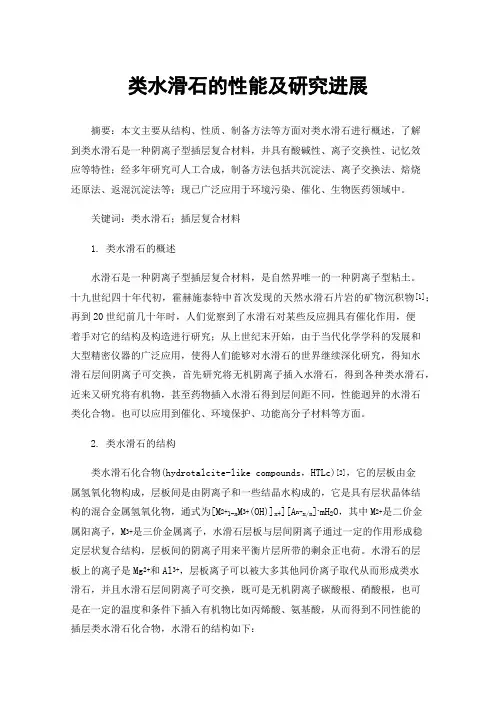
类水滑石的性能及研究进展摘要:本文主要从结构、性质、制备方法等方面对类水滑石进行概述,了解到类水滑石是一种阴离子型插层复合材料,并具有酸碱性、离子交换性、记忆效应等特性;经多年研究可人工合成,制备方法包括共沉淀法、离子交换法、焙烧还原法、返混沉淀法等;现已广泛应用于环境污染、催化、生物医药领域中。
关键词:类水滑石;插层复合材料1. 类水滑石的概述水滑石是一种阴离子型插层复合材料,是自然界唯一的一种阴离子型粘土。
十九世纪四十年代初,霍赫施泰特中首次发现的天然水滑石片岩的矿物沉积物[1];再到20世纪前几十年时,人们觉察到了水滑石对某些反应拥具有催化作用,便着手对它的结构及构造进行研究;从上世纪末开始,由于当代化学学科的发展和大型精密仪器的广泛应用,使得人们能够对水滑石的世界继续深化研究,得知水滑石层间阴离子可交换,首先研究将无机阴离子插入水滑石,得到各种类水滑石,近来又研究将有机物,甚至药物插入水滑石得到层间距不同,性能迥异的水滑石类化合物。
也可以应用到催化、环境保护、功能高分子材料等方面。
2. 类水滑石的结构类水滑石化合物(hydrotalcite-like compounds,HTLc)[2],它的层板由金属氢氧化物构成,层板间是由阴离子和一些结晶水构成的,它是具有层状晶体结构的混合金属氢氧化物,通式为[M2+1-x M3+(OH)]x+][A n-x/n]·mH2O,其中M2+是二价金属阳离子,M3+是三价金属离子,水滑石层板与层间阴离子通过一定的作用形成稳定层状复合结构,层板间的阴离子用来平衡片层所带的剩余正电荷。
水滑石的层板上的离子是Mg2+和Al3+,层板离子可以被大多其他同价离子取代从而形成类水滑石,并且水滑石层间阴离子可交换,既可是无机阴离子碳酸根、硝酸根,也可是在一定的温度和条件下插入有机物比如丙烯酸、氨基酸,从而得到不同性能的插层类水滑石化合物,水滑石的结构如下:图2水滑石的结构3. 类水滑石的性质3.1 酸碱性水滑石的的层板间的金属离子显现一定的酸性,但是层间的羟基又显现出一定的碱性,因此水滑石的酸碱性会因层板上的金属阳离子和层间的阴离子的不同而改变。
水滑石制备方法讨论进展自然存在的水滑石是镁、铝的羟基碳酸化合物,又被称为双金属氢氧化物或阴离子性黏土,它是一种典型的层状阴离子型化合物。
天然存在的水滑石大都是镁铝水滑石,其层间阴离子重要为CO32—。
天然的镁铝水滑石活着界范围内特别有限,因而镁铝水滑石的工业化生产和应用引起了国内外讨论者的紧密关注。
镁铝水滑石具有独特的结构特性、构成及优良的催化性能,因而具有很多的功能特性,可作为催化材料、分别与吸附材料、离子交换剂、光电磁功能材料等应用于多个领域,其制备与合成方法也自然成为近些年国内外讨论的热点。
目前,镁铝水滑石的合成方法较多,其中,常用的重要包括共沉淀法、水热合成法、离子交换法、微波辐射法等。
1.共沉淀法共沉淀法是制备镁铝水滑石最常用的方法。
该法是在肯定温度和pH条件下,将可溶性铝盐和镁盐与沉淀剂混合在一起使之反应,生成胶状的沉淀物,静置、晶化、过滤、洗涤得到目标产物。
共沉淀的基本条件是达到过饱和状态,一般是通过调整反应体系的pH来充足,使pH高于或至少等于反应体系中最易溶金属氢氧化物的沉淀pH。
依据沉淀条件不同,共沉淀法可分为单滴法、双滴法、成核/晶化隔离法和尿素分解法等。
1.1单滴法单滴法是将含有构成镁铝水滑石层板金属离子的混合盐溶液在猛烈搅拌下逐滴加入到含有镁铝水滑石层间阴离子的碱溶液中,再于肯定的温度下晶化一段时间。
滴加过程中体系pH持续变化,镁铝水滑石在高过饱和状态下进行成核和生长,所以该法也称为pH值法或高过饱和度法。
1.2双滴法双滴法是将含有构成镁铝水滑石层板金属离子的混合盐溶液和含有镁铝水滑石层间阴离子的碱溶液通过掌控滴加速度缓慢滴加到搅拌容器中,反应体系的pH一般是通过调整碱溶液的滴加速度来掌控。
该方法通过调整溶液浓度和掌控滴加速度使水滑石的成核和生长过程始终处于低过饱和状态下,所以该法被称为恒pH值法或低过饱和度法。
1.3成核/晶化隔离法该法是将含有构成镁铝水滑石层板金属离子的混合盐溶液和含镁铝水滑石层间阴离子的混合碱溶液加入到全返混旋转液膜成核反应器中混和,猛烈搅拌,在转子和定子夹缝间的高剪切力作用下快速形成镁铝水滑石晶核,再将浆液在肯定温度下晶化,使晶核成长。